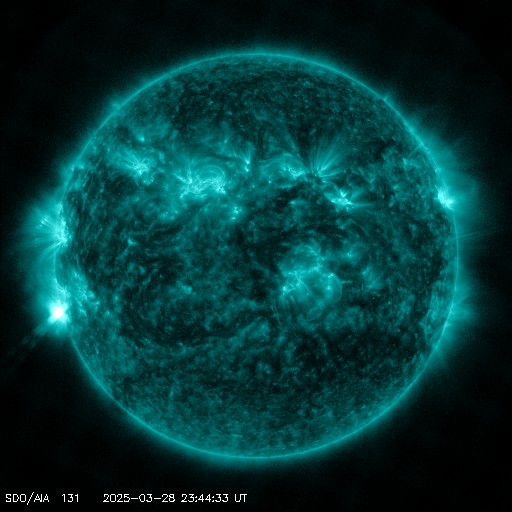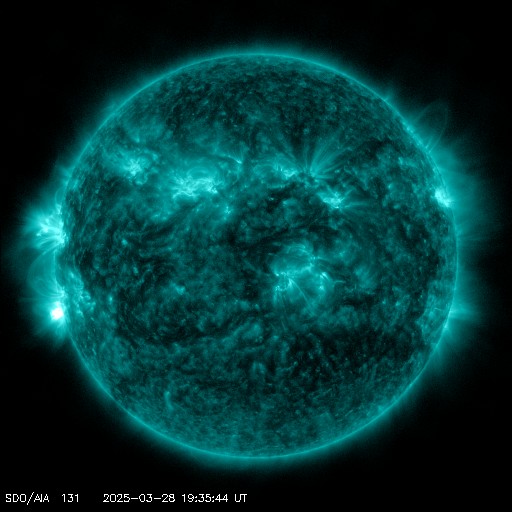Viewing archive of Sunday, 17 June 2001
Solar activity report
Any mentioned solar flare in this report has a scaling factor applied by the Space Weather Prediction Center (SWPC). Because of the SWPC scaling factor, solar flares are reported as 42% smaller than for the science quality data. The scaling factor has been removed from our archived solar flare data to reflect the true physical units.
Report of Solar-Geophysical Activity 2001 Jun 17 2200 UTCPrepared by the NOAA © SWPC and processed by SpaceWeatherLive.com
Joint USAF/NOAA Report of Solar and Geophysical Activity
SDF Number 168 Issued at 2200Z on 17 Jun 2001IA. Analysis of Solar Active Regions and Activity from 16-2100Z to 17-2100Z
Solar activity has been low. Today's largest event was
a C3 at 2242 UTC which was not seen optically. Region 9503 (N14E20)
is currently the largest group on the disk, and shows continued
growth, enhanced plage and occasional brightenings. Region 9501
(S13W11) has also shown growth during the past 24 hours. Region 9502
(S25E05) continues to have an east-west inversion line, but appeared
to be a bit cooler today than previously. Region 9506 (N17E48) has
rotated into view as a beta-gamma group, but was relatively calm and
stable. Two filaments disappeared during the past 24 hours: a 14
degree filament near S27W11, and a 28 degree filament near N30E55.
IB. Solar Activity Forecast
Solar activity is expected to be low
to moderate for the next three days. There is a slight chance,
however, for an isolated major flare event, particularly from 9503
and 9506.
IIA. Geophysical Activity Summary 16-2100Z to 17-2100Z
The geomagnetic field ranged from quiet to active levels. Quiet
conditions prevailed during the first 15 hours of the period, but
activity increased to unsettled to slightly active between 1200-2100
UTC. Solar wind signatures showed some kind of transient type flow
from 0300-1600 UTC which was accompanied be moderately negative
interplanetary Bz.
IIB. Geophysical Activity Forecast
The geomagnetic field for the
next 24 hours is expected to be mostly unsettled, but with a chance
for isolated active periods. Unsettled levels should prevail on the
second day, and activity should drop to quiet to unsettled levels by
the third day.
III. Event Probabilities 18 Jun to 20 Jun
| Class M | 60% | 60% | 60% |
| Class X | 10% | 10% | 10% |
| Proton | 05% | 10% | 10% |
| PCAF | green | ||
IV. Penticton 10.7 cm Flux
Observed 17 Jun 205 Predicted 18 Jun-20 Jun 200/200/195 90 Day Mean 17 Jun 172
V. Geomagnetic A Indices
Observed Afr/Ap 16 Jun 004/007 Estimated Afr/Ap 17 Jun 010/012 Predicted Afr/Ap 18 Jun-20 Jun 015/015-010/010-005/010
VI. Geomagnetic Activity Probabilities 18 Jun to 20 Jun
| A. Middle Latitudes | |||
|---|---|---|---|
| Active | 35% | 25% | 20% |
| Minor storm | 15% | 15% | 10% |
| Major-severe storm | 10% | 05% | 05% |
| B. High Latitudes | |||
|---|---|---|---|
| Active | 35% | 30% | 25% |
| Minor storm | 25% | 20% | 15% |
| Major-severe storm | 15% | 10% | 05% |
All times in UTC
Current data suggests there is a slight possibility for aurora to appear at the following high latitude regions in the near future
UtsjokiKirkenes
Murmansk
Latest news
Latest forum messages
AR4048 2Incoming & Unnumbered Active Regions 1658Aurora photography hints for those of us with smartphones 51AR4046 127Large Coronal Hole 25 178
More topicsSupport SpaceWeatherLive.com!
A lot of people come to SpaceWeatherLive to follow the Sun's activity or if there is aurora to be seen, but with more traffic comes higher server costs. Consider a donation if you enjoy SpaceWeatherLive so we can keep the website online!

Latest alerts
00:00 UTC - Solar flare
Moderate M1.79 flare
Friday, 28 March 2025
23:36 UTC - Radio Blackout
Minor R1 radio blackout in progress (≥M1 - current: M1.04)
21:24 UTC - Hemispheric Power Index
The OVATION model predicts the Hemispheric Power Index to reach 51GW at 21:59 UTC
19:45 UTC - Solar flare
Moderate M1.16 flare
19:27 UTC - Radio Blackout
Minor R1 radio blackout in progress (≥M1 - current: M1.1)
Space weather facts
| Last X-flare | 2025/03/28 | X1.1 |
| Last M-flare | 2025/03/28 | M1.7 |
| Last geomagnetic storm | 2025/03/27 | Kp5 (G1) |
| Spotless days | |
|---|---|
| Last spotless day | 2022/06/08 |
| Monthly mean Sunspot Number | |
|---|---|
| February 2025 | 154.6 +17.6 |
| March 2025 | 128.3 -26.4 |
| Last 30 days | 128.3 -23.7 |




